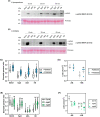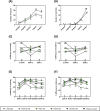Signalling mechanisms and agricultural applications of (Z)-3-hexenyl butyrate-mediated stomatal closure
- PMID: 38239809
- PMCID: PMC10794947
- DOI: 10.1093/hr/uhad248
Signalling mechanisms and agricultural applications of (Z)-3-hexenyl butyrate-mediated stomatal closure
Abstract
Biotic and abiotic stresses can severely limit crop productivity. In response to drought, plants close stomata to prevent water loss. Furthermore, stomata are the main entry point for several pathogens. Therefore, the development of natural products to control stomata closure can be considered a sustainable strategy to cope with stresses in agriculture. Plants respond to different stresses by releasing volatile organic compounds. Green leaf volatiles, which are commonly produced across different plant species after tissue damage, comprise an important group within volatile organic compounds. Among them, (Z)-3-hexenyl butyrate (HB) was described as a natural inducer of stomatal closure, playing an important role in stomatal immunity, although its mechanism of action is still unknown. Through different genetic, pharmacological, and biochemical approaches, we here uncover that HB perception initiates various defence signalling events, such as activation of Ca2+ permeable channels, mitogen-activated protein kinases, and production of Nicotinamide adenine dinucleotide phosphate (NADPH) oxidase-mediated reactive oxygen species. Furthermore, HB-mediated stomata closure was found to be independent of abscisic acid biosynthesis and signalling. Additionally, exogenous treatments with HB alleviate water stress and improve fruit productivity in tomato plants. The efficacy of HB was also tested under open field conditions, leading to enhanced resistance against Phytophthora spp. and Pseudomonas syringae infection in potato and tomato plants, respectively. Taken together, our results provide insights into the HB signalling transduction pathway, confirming its role in stomatal closure and plant immune system activation, and propose HB as a new phytoprotectant for the sustainable control of biotic and abiotic stresses in agriculture.
© The Author(s) 2024. Published by Oxford University Press on behalf of Nanjing Agricultural University.
Conflict of interest statement
None declared.
Figures






Similar articles
-
A New Role For Green Leaf Volatile Esters in Tomato Stomatal Defense Against Pseudomonas syringe pv. tomato.Front Plant Sci. 2018 Dec 18;9:1855. doi: 10.3389/fpls.2018.01855. eCollection 2018. Front Plant Sci. 2018. PMID: 30619420 Free PMC article.
-
Mechanism of Stomatal Closure in Plants Exposed to Drought and Cold Stress.Adv Exp Med Biol. 2018;1081:215-232. doi: 10.1007/978-981-13-1244-1_12. Adv Exp Med Biol. 2018. PMID: 30288712 Review.
-
Abscisic Acid-Induced Stomatal Closure: An Important Component of Plant Defense Against Abiotic and Biotic Stress.Front Plant Sci. 2021 Mar 4;12:615114. doi: 10.3389/fpls.2021.615114. eCollection 2021. Front Plant Sci. 2021. PMID: 33746999 Free PMC article. Review.
-
Signaling Transduction of ABA, ROS, and Ca2+ in Plant Stomatal Closure in Response to Drought.Int J Mol Sci. 2022 Nov 26;23(23):14824. doi: 10.3390/ijms232314824. Int J Mol Sci. 2022. PMID: 36499153 Free PMC article. Review.
-
Stomata: gatekeepers of uptake and defense signaling by green leaf volatiles in maize.J Exp Bot. 2024 Nov 15;75(21):6872-6887. doi: 10.1093/jxb/erae401. J Exp Bot. 2024. PMID: 39397371
Cited by
-
Salicylic Acid Modulates Volatile Organic Compound Profiles During CEVd Infection in Tomato Plants.Metabolites. 2025 Feb 6;15(2):102. doi: 10.3390/metabo15020102. Metabolites. 2025. PMID: 39997727 Free PMC article.
-
Genotype-dependent responses to HIPV exposure in citrus: repression of CsPUB21 and activation of SA/JA signaling.Front Plant Sci. 2025 Jun 25;16:1605151. doi: 10.3389/fpls.2025.1605151. eCollection 2025. Front Plant Sci. 2025. PMID: 40636014 Free PMC article.
-
RNA-Seq Bulked Segregant Analysis of an Exotic B. napus ssp. napobrassica (Rutabaga) F2 Population Reveals Novel QTLs for Breeding Clubroot-Resistant Canola.Int J Mol Sci. 2024 Apr 23;25(9):4596. doi: 10.3390/ijms25094596. Int J Mol Sci. 2024. PMID: 38731814 Free PMC article.
-
Plant volatile-triggered defense in citrus against biotic stressors.Front Plant Sci. 2024 Jul 10;15:1425364. doi: 10.3389/fpls.2024.1425364. eCollection 2024. Front Plant Sci. 2024. PMID: 39049855 Free PMC article.
-
Do guard cells have single or multiple defense mechanisms in response to flg22?Physiol Plant. 2025 May-Jun;177(3):e70249. doi: 10.1111/ppl.70249. Physiol Plant. 2025. PMID: 40351283 Free PMC article.
References
-
- Jones JDG, Dangl JL. The plant immune system. Nature. 2006;444:323–9 - PubMed
-
- Boutrot F, Zipfel C. Function, discovery, and exploitation of plant pattern recognition receptors for broad-spectrum disease resistance. Annu Rev Phytopathol. 2017;55:257–86 - PubMed
-
- Zhang J, Zhou JM. Plant immunity triggered by microbial molecular signatures. Mol Plant. 2010;3:783–93 - PubMed
-
- Cui H, Tsuda K, Parker JE. Effector-triggered immunity: from pathogen perception to robust defense. Annu Rev Plant Biol. 2015;66:487–511 - PubMed
LinkOut - more resources
Full Text Sources
Miscellaneous

